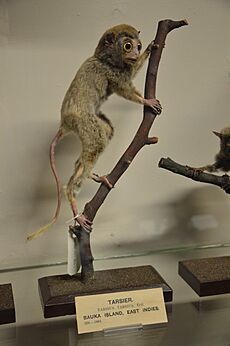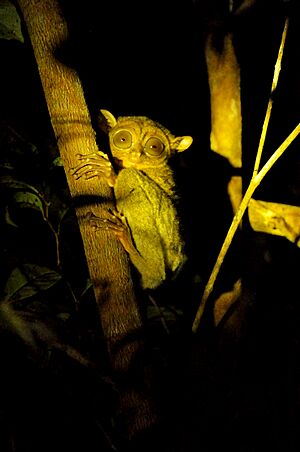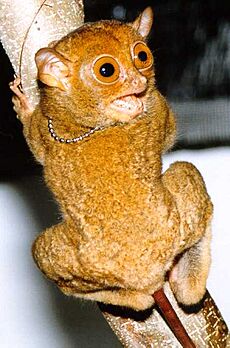Horsfield's tarsier facts for kids
Quick facts for kids Western tarsier |
|
|---|---|
 |
|
| Cephalopachus bancanus borneanus | |
| Conservation status | |
| Scientific classification | |
 |
|
| Western tarsier range |
The Western tarsier, also called Horsfield's tarsier (its scientific name is Cephalopachus bancanus), is a tiny primate. It's the only type of tarsier in its special group, Cephalopachus. This small animal was named after a naturalist named Thomas Horsfield. You can find Western tarsiers on the islands of Borneo, Sumatra, and other nearby islands. Like all tarsiers, they are active only at night.
Contents
What is a Western Tarsier?
For a long time, the Western tarsier was grouped with all other living tarsiers in the genus Tarsius. However, scientists noticed it was quite different. It looked and acted differently from the Philippine tarsier and other tarsiers found near Sulawesi.
Because of these differences, scientists decided to give the Western tarsier its own separate genus. They named this new group Cephalopachus. This helps show how unique this particular tarsier is.
Different Types of Western Tarsiers
Scientists are still studying the Western tarsier. They are not entirely sure about all its different types, called subspecies. For over 20 years, not many studies have focused on C. bancanus.
The IUCN (International Union for Conservation of Nature) suggests that these different types should be treated as separate for now. This is until more clear evidence is found. When the species was put into its own genus, scientists recognized four main subspecies:
- Cephalopachus bancanus bancanus
- Cephalopachus bancanus saltator — This is the Belitung Island tarsier.
- Cephalopachus bancanus borneanus — This is the Bornean tarsier.
- Cephalopachus bancanus natunensis — This is the Natuna Islands tarsier.
Physical Features of the Western Tarsier
The fur of a Western tarsier can be different colors. It might be pale-olive, reddish-brown, or even light or dark grey-brown. Its color might change as it gets older.
These tarsiers are small. Their body, from head to tail, is about 12 to 15 centimeters (5 to 6 inches) long. They have a very long tail, which can be 18 to 22 centimeters (7 to 9 inches) long. This tail is mostly hairless, except for some tufts of hair at the very end.
Special Body Parts
Western tarsiers have two special grooming claws on each foot. Their fingers are very long and have soft pads on the tips. Their toes have flat nails, except for the second and third toes on their back feet. These toes have claw-like nails.
They have very large eyes that do not reflect light. Their ears are thin, almost bare, and look like membranes. The teeth at the back of their mouth, called molars, have high points. This helps them chew their food.
Where Western Tarsiers Live
You can find Horsfield's tarsier in southern Sumatra, Borneo, and islands nearby. The Bornean subspecies, C. b. borneanus, lives in many low-lying areas. These include Sabah, Brunei, Sarawak, and West Kalimantan. They can also be found higher up, over 900 meters (about 3,000 feet), in the Kelabit Highlands in northern Sarawak.
Other places where they have been seen include Kutai and Peleben in East Kalimantan. They are also found in Tanjung Maruwe in Central Kalimantan. These tarsiers can live in both old, untouched forests and forests that have grown back after being cut down. They also live in forests along the coasts or near the edges of farms.
Western Tarsier Behavior and Daily Life
The Western tarsier is a nocturnal animal. This means it is active only at night. During the day, it sleeps alone in a tangle of vines or climbing plants. It usually sleeps about 3.5 to 5 meters (11 to 16 feet) off the ground.
These tarsiers like to sleep or rest on tree trunks that are angled slightly, about 5 degrees from straight up. The branches they choose are usually 1 to 4 centimeters (0.4 to 1.6 inches) wide. They always sleep by themselves.
Nighttime Activities
Before the sun sets, the Western tarsier wakes up. It waits for about 10 to 20 minutes before it starts moving around. It spends about 1.5 to 2 hours of the night looking for food. Western tarsiers can be found from the ground level up to 7 meters (23 feet) or more in the forest undergrowth.
What Western Tarsiers Eat
This species is a carnivore, meaning it eats meat. It mainly eats insects. Some of its favorite insect foods include beetles, grasshoppers, katydids, cockroaches, butterflies, moths, praying mantis, ants, stick insects, and cicadas.
They also eat small vertebrates, which are animals with backbones. These can include bats, snakes (even poisonous ones like the Maticora intestinalis), and birds. They have been known to eat spiderhunters, warblers, kingfishers, and pittas.
The tarsier finds its prey mostly by listening. It catches the prey with its hands. When it attacks, it bites the back of the prey's neck and shuts its eyes. It starts eating the prey from the head down. Western tarsiers get water by drinking from pools or streams. They also lick water drops from bamboo leaves or tree trunks.
How Western Tarsiers Move
Like all tarsiers, the Western tarsier is an amazing jumper. It can cling to vertical surfaces and leap long distances. It mainly uses its feet to support itself. The pads on its feet and its tail are strong enough to hold it in place without using its hands much.
When resting, its hands are usually placed no higher than its nose. It only places its hands higher to keep its balance. Other ways it moves include climbing, walking on all fours, hopping, and a special move called "cantilevering."

Reproduction and Life Cycle
Western tarsiers are monogamous, meaning they have one partner. During courtship, the male makes special calls. He chirps 2–3 times while opening and closing his mouth. This call happens within five minutes of him seeing the female.
Baby tarsiers are born with their eyes open and are fully covered in fur. They can even groom themselves right away. The mother carries her baby in her mouth. When she goes to find food, she will "park" the baby safely on a branch.
Baby tarsiers make clicking sounds like "k," "tk," "ki," or a quick "kooih." You can hear these sounds when the baby is left alone or feels cold. The mother stays in touch with her babies using high-pitched calls. Young tarsiers start using their tails for support when resting at about 7 to 10 days old. When they reach puberty, young tarsiers leave their parents' area and find their own territory.
Social Habits
Western tarsiers mostly groom themselves. Social grooming, where one tarsier grooms another, only happens between mothers and their babies. They remove dead skin and parasites by scratching with their toe claws and licking their fur. They avoid cleaning each other's faces. Faces are cleaned by rubbing them on branches. This grooming helps strengthen the bond between mother and baby.
Western tarsiers mark their territory using scents. They use urine and special liquids from glands. They rub these scents on surfaces while scratching with their back foot claws.
Protecting the Western Tarsier
The Western tarsier faces many threats. Its home is disappearing quickly because forests are being cut down. This happens for things like turning land into palm oil farms, or due to fires and logging.
Also, these tarsiers are sometimes caught illegally to be sold as pets. Some people also wrongly think they are pests that harm crops. They can also suffer from pesticides used on farms.
Conservation Efforts
The Western tarsier is listed as a vulnerable species by the IUCN Red List of Threatened Species (2008). This means it is at high risk of becoming endangered. It is also protected by CITES Appendix II, which controls trade in endangered species. It is protected by law in both Indonesia and Malaysia.
In February 2007, the governments of Brunei, Malaysia, and Indonesia agreed to protect a large area of tropical forest. This area is about 220,000 square kilometers (85,000 square miles) and is called the "Heart of Borneo" region. The environmental group WWF played a big part in setting up this protected area.
In the "Heart of Borneo" project, non-governmental organizations (NGOs) have helped a lot. They promoted this important idea and helped the countries involved plan and carry it out. The goal is to improve how biodiversity (all the different kinds of life) is protected in Borneo's forests. They also want to make sure these forests are not just turned into farms, like palm oil plantations, after trees are cut down.




